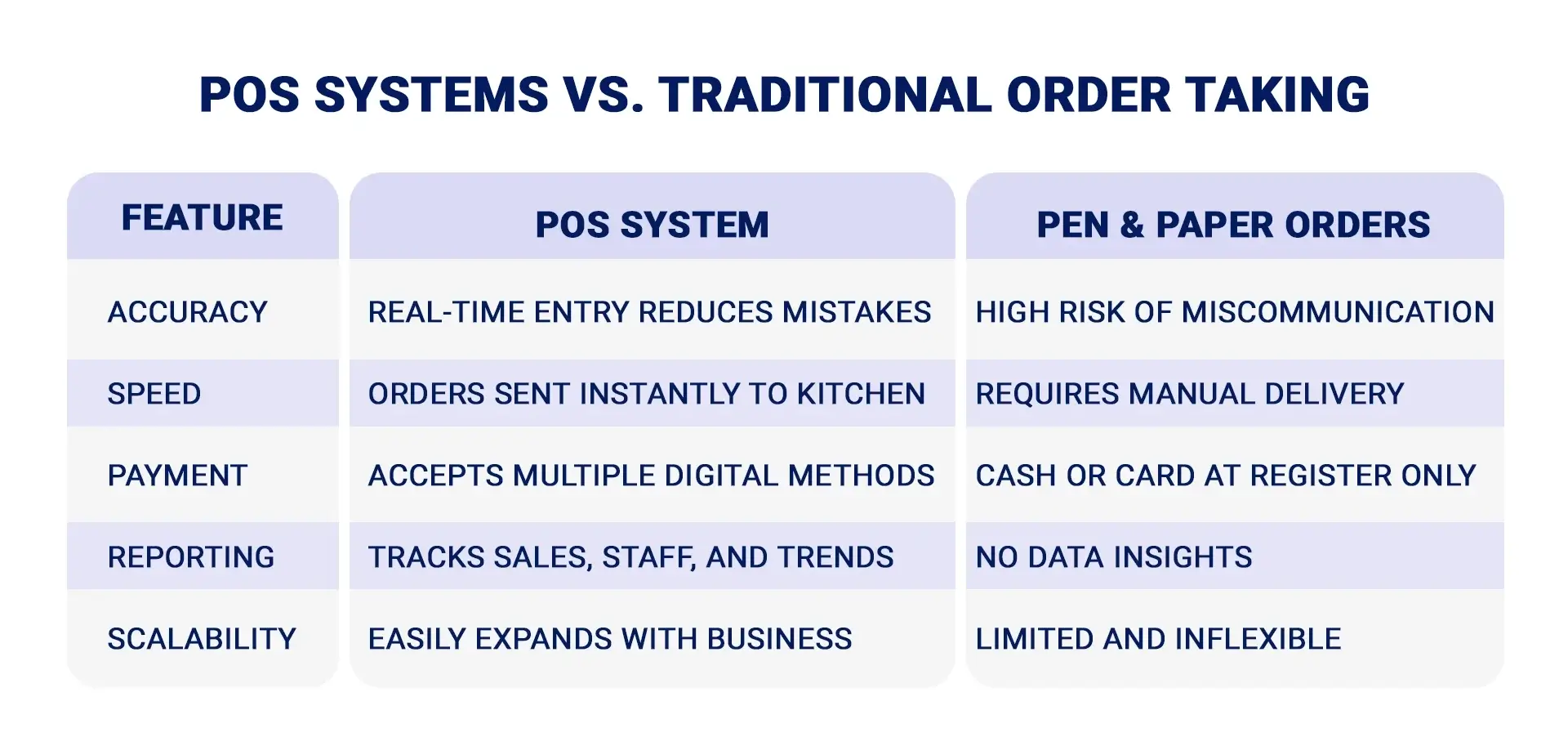In the past, restaurant waiters relied on pen and paper to jot down orders, mental math to split bills, and trips back and forth between tables and the register. Today, modern Point of Sale (POS) systems have transformed how waiters work making their jobs faster, more accurate, and more customer-friendly.
But how exactly does a waiter use a POS system? From setup and training to daily operations and after-hours reporting, this guide walks through every step of the process.

POS systems streamline a waiter’s workflow from order-taking to payments and reporting.
Handheld POS devices and kitchen display systems (KDS) improve speed and reduce errors.
Proper training ensures smooth adoption and confident staff.
Real-time analytics help restaurants optimize menus, staffing, and service.
A POS system in a restaurant acts as the central hub for order-taking, payment processing, and table management. For waiters, it’s more than just a cash register it’s their main tool for interacting with both the kitchen and customers.
Using mobile POS devices or terminals, waiters can send orders directly to the kitchen, process payments at the table, and even track customer preferences. In short, a POS system connects the dining room with the back-of-house, creating a seamless service experience.
Identify needs: Quick-service and fine-dining restaurants require different features.
Evaluate features: Look for order management, menu customization, and integrated payments.
User-friendliness: An intuitive system reduces training time.
Scalability: Choose a system that grows with your business.
Free trial/demo: Test performance before committing.
Handheld devices: Tablets or smartphones allow tableside ordering.
Kitchen Display System (KDS): Sends orders to the kitchen instantly.
Card readers: Accept chip, tap, and mobile payments securely.
Receipt printer & cash drawer: Handle traditional payment needs.
Networking equipment: A strong internet connection ensures smooth performance.
Menu setup: Enter categories, prices, and modifiers like “extra sauce.”
User roles: Assign permissions for waiters, bartenders, and managers.
Table layout: Mirror the restaurant’s floor plan for quick table management.
Hands-on practice: Train waiters in small groups.
Mock scenarios: Practice split bills, discounts, and refunds.
Training materials: Provide quick-reference guides or built-in tutorials.
Encourage learning: Treat mistakes as part of the process.
In daily restaurant operations, a POS system becomes the waiter’s essential tool. From taking accurate orders tableside and sending them instantly to the kitchen, to managing table flow, splitting bills, and processing secure payments, the system simplifies every step. This ensures faster service, fewer errors, and a better customer experience.

Tableside entry: Waiters take orders directly at the table using handheld POS devices.
Real-time kitchen communication: Orders appear instantly on the KDS, reducing errors.
Accurate modifiers: Special requests are recorded clearly, ensuring customer satisfaction.
Course timing: POS helps manage when dishes are sent out.
Bill splitting: The system calculates and divides bills by item or percentage instantly.
Flexible options: Accepts cash, cards, mobile wallets, and gift cards.
On-the-spot payments: Waiters close checks tableside for faster turnover.
Receipts: Customers can receive digital or printed copies.
A POS system’s role doesn’t end when the restaurant closes. Beyond daily transactions, it delivers valuable sales insights, tracks waiter performance, and supports smarter business decisions with detailed reporting. Regular software updates, reliable support, and secure data backups ensure smooth operations. By also evaluating upfront investments, subscription fees, and add-on features, restaurants can accurately measure the total cost of ownership and plan for long-term success.

Sales insights: Track popular menu items and sales trends.
Performance tracking: Monitor individual waiter performance.
Data-driven decisions: Adjust staffing, menus, or promotions with real data.
Software updates: Ensure access to the latest features and security patches.
Support availability: Choose a provider with reliable, ideally 24/7, support.
Data backups: Protect against data loss in case of hardware failure.
Upfront costs: Hardware and installation.
Ongoing costs: Monthly subscriptions and transaction fees.
Add-ons: Features like loyalty programs may cost extra.
Total cost of ownership: Factor in updates, training, and long-term support.

Faster service: Fewer trips to the point of sale and kitchen.
Improved accuracy: Clear orders and fewer kitchen mistakes.
Better customer experience: Seamless payments and personalized service.
Data insights: Helps staff and management understand performance.
Keep up with regular training and system updates.
Use modifiers carefully to avoid kitchen errors.
Track your own sales reports for personal growth.
Encourage customers to use mobile/table payments.
Share feedback with management for continuous improvements.
1. Do waiters need special training to use a POS system?
Yes, training is essential. While modern POS systems are user-friendly, staff should learn order entry, modifications, bill splitting, and payment handling. With SalesPlay POS, restaurants can create user roles and permissions to make training easier and more structured.
2. Can waiters split checks or handle group payments with POS systems?
Absolutely. POS systems allow waiters to split checks by item, seat, or percentage. This removes the hassle of manual calculations and ensures billing accuracy for groups.
3. How does a POS system improve communication with the kitchen?
When a waiter enters an order into the POS, it’s instantly sent to the kitchen via a Kitchen Display System (KDS) or printer. SalesPlay POS integrates seamlessly with KDS, ensuring orders reach the kitchen in real time with fewer errors.
4. Do POS systems let waiters process payments at the table?
Yes. With handheld or mobile POS devices, waiters can process payments tableside. This provides convenience for customers, speeds up table turnover, and enhances security since the card never leaves the guest’s sight.
5. Can waiters manage customer preferences with a POS?
Many modern POS systems have built-in CRM features. Waiters can view customer order history, note dietary restrictions, or recognize frequent guests. This allows for personalized service and loyalty program integration.
6. What happens if the internet goes down? Can waiters still use the POS?
Many POS systems, including cloud-based ones, offer an offline mode. Waiters can continue taking orders and processing payments, and the system syncs automatically once the internet is restored.
7. How do POS systems help managers track waiter performance?
POS systems generate detailed reports that include sales per waiter, average table turnover time, and upselling performance. This data helps managers provide feedback, assign shifts, and reward top-performing staff.
8. Are POS systems secure for payments?
Yes. Modern POS systems use encryption and meet PCI compliance standards. SalesPlay POS ensures secure payment processing, so waiters and customers can trust every transaction.
A waiter’s role in a restaurant is all about delivering great service quickly and accurately. With a modern POS system, waiters can take orders, manage tables, and process payments with ease—all while helping management collect valuable data.
If you’re ready to transform your restaurant’s service, consider a solution like SalesPlay POS, which offers handheld ordering, real-time reporting, and scalability for growing businesses.
👉 Learn more about SalesPlay POS here and see how it can streamline your restaurant operations.